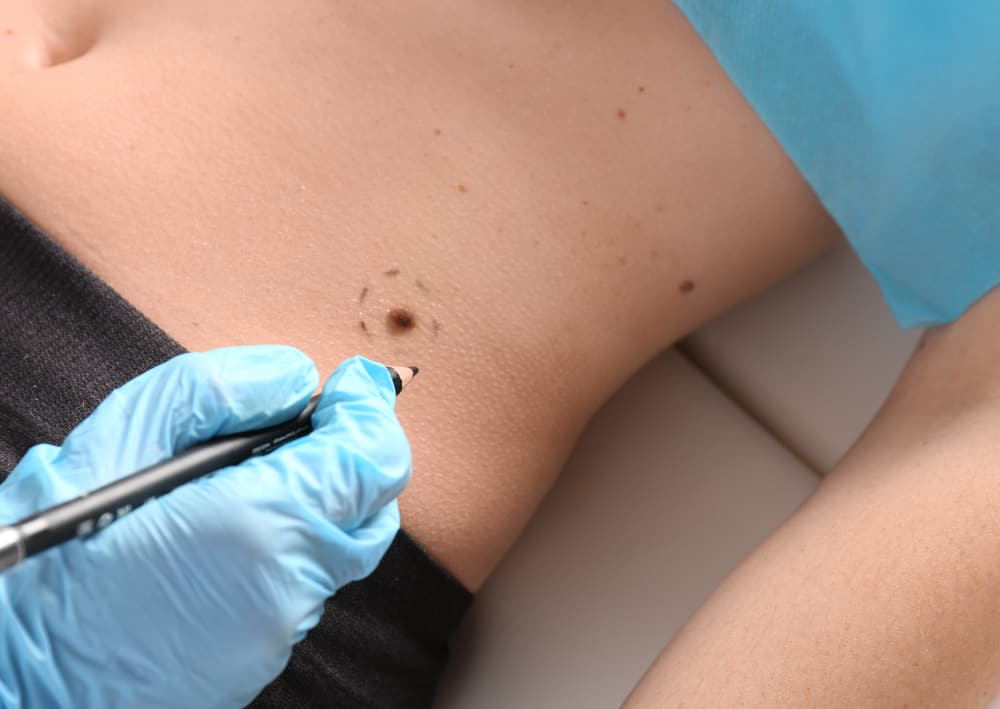Cancer continues to be one of the leading causes of death globally, despite advances in technology and treatment. Skin cancer is one of the top cancers in Australia, New Zealand, and many European countries. As per studies and statistics, skin cancer is more likely in Caucasians or light-skinned individuals with blonde or red hair and those living in areas further away from the equator. While skin cancer is less of a concern for Filipinos, there are still thousands of Filipinos who get diagnosed with some type of skin cancer. Thankfully, skin cancer treatment is available and has a high success rate when detected early on.

Skin cancer detection and staging
Before skin cancer can be treated, it should be diagnosed by a doctor. Skin cancer is one of the most treatable types of cancer, especially when spotted in its early stage. Unlike cancers of other organs, signs of skin cancer can be more easily spotted with the naked eye. Keep an eye on suspicious moles (nevi) and skin growths that change color, shape, or size over time. Moles and freckles are common in areas that are frequently exposed to the sun, however, numerous or irregular markings can be an early sign of melanoma.
Know your ABCDEs of melanoma
- Asymmetry: irregularly-shaped (not round) moles.
- Borders: uneven or notched edges of a mole.
- Color: normal moles should be a single, uniform color. Melanomas may range from brown or black to red, blue, or even white.
- Diameter: moles that are larger than the diameter of a pencil eraser (6 mm) are a cause for alarm. However, even smaller moles can still be a risk.
- Evolution: moles or freckles that change in color, shape, or size over months or years are some of the most telling signs of melanoma. This indicates that the cells in this area are undergoing active, rapid growth, which is a quality of all cancers.
Aside from melanoma, basal cell carcinoma (BCC) is another common type of skin cancer. In fact, according to some data, BCC is responsible for up to 80% of all non-melanoma skin cancers. BCC usually appears as a dark papule or lump on the skin that tends to bleed and crust. It is less deadly than melanomas, as it rarely metastasizes or spreads to other parts of the body.
To get an accurate diagnosis, a doctor will most likely request for a biopsy. A biopsy is a sample of tissue taken from the suspected area. The sample will be examined under a microscope and will help your doctor determine the stage and treatment options.
Skin cancer treatment options
Skin cancer treatment for melanoma
- Wide excision
- Lymph node dissection
- Radiation therapy (for regional melanoma or patients who cannot undergo surgery)
- Systemic chemotherapy (for metastatic disease)
Skin cancer treatment for basal cell carcinoma
- Curettage and electrodessication (C&E)
- Standard or wide excision
- Mohs micrographic surgery
- Radiation therapy
- Systemic chemotherapy
Skin cancer treatment for squamous cell carcinoma
- Photodynamic (light) therapy
- Cryotherapy
- Topical therapy
- Curettage and electrodessication (C&E)
- Standard or wide excision
- Mohs micrographic surgery
- Radiation therapy
- Systemic chemotherapy
What to expect during and after treatment
Unlike cancers that affect internal organs or the blood, skin cancer responds well to surgical removal. For cancers that have spread or the patient is not a candidate for surgery, radiation therapy may be used. For advanced cancers that have metastasized (spread) to other organs, chemotherapy is necessary.
During surgery, you will be given anesthesia. This will cause numbness in the area so you won’t feel any pain. Most surgeons prefer to give local anesthesia instead of general anesthesia because they have less risks and side effects. Skin cancer surgery is fairly quick compared to other types of surgery.
After skin cancer treatment, you can expect to feel some soreness or pain. You will have some stitches to close the incisions and allow the skin to heal nicely. You will likely notice some liquid or blood oozing for a few days after the surgery. As a scab forms, the stitches may feel itchy. Clean and disinfect the area as needed and avoid scratching or touching it. Radiotherapy may cause some nausea or gastrointestinal disturbances in some patients if their abdomen is irradiated.
In the case your skin cancer treatment requires chemotherapy, your doctor and pharmacist will educate you on how these medications are taken. Chemotherapy differs from drugs used to treat other illnesses. Instead of taking doses several times a day, chemotherapy is done in cycles with intervals of several weeks. Chemotherapy drugs often cause unwanted side effects such as fatigue, hair loss, increased risk of infection, and GI problems. Your doctor may give other medications to treat these effects.
Key takeaways
In summary, skin cancer treatment is fairly straight-forward compared to other types of cancers. Early detection is the most important factor when it comes to treatment success. Fortunately, most types of skin cancers only require surgery which has fewer side effects than chemotherapy. Talk to your doctor today if you notice any suspicious moles or marks on your skin and always remember to wear sunscreen and limit your exposure to sunlight to reduce you risk of developing skin cancer.




















